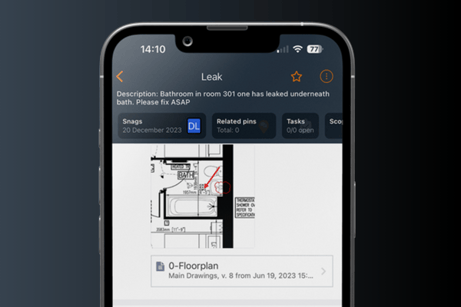Let’s talk snagging. Snag lists. Issues. Construction glitches. Whatever you prefer to call it, it’s a crucial part of construction projects that every builder is familiar with. There’s no way to sugar-coat it – you NEED a process for tracking snags; it is vital to keep a track of pesky imperfection or issues before they snowball into big headaches that can affect a project’s timeline and costs further down the line. Snagging ensures all work is delivered to the highest quality, so getting it right is and always has been important.
But here’s the thing: Even though snagging is essential on any construction site, traditional methods of tracking aren’t up to par with more modern and advanced ways of working. Jotting down snags using pen and paper can sometimes feel like construction is stuck in the stone age when there are several solutions out there to make the whole process easier and more streamlined.
We know it’s not always easy to adopt new ways of working, using technology can seem like too big a mountain to climb but the benefits of a digital snagging process far outweigh any negatives of implementation.
Having somewhere to manage all of your projects will save you the money you spend on it - in the losses you would have made from not being organised in the first place." Callum Knapp, BLDG Construction
What is snagging in construction?
You already know this, right? Sometimes called issue logging or defect management, snagging is the capture of any defects, imperfection or incomplete works that arise on a building site. These issues need to be recorded as part of a construction project and usually require attention or sign off before they can be completed. Snags can include anything from paint scratches or chipped tiles to holes in brickwork and structural flaws or safety hazards. Addressing snagging ensures that the final build meets quality standards and meets all building regulations.
Why is snag list software important?
Far from being just about ‘fixing issues’, snagging is essential to ensure the highest quality of a build. While traditionally restricted to the realm of new build housing, snagging has its place on any type of construction site. A good snagging process means that final customers can be assured of the highest build quality. No matter how thorough a construction team, there will always be potential defects and problems and being able to demonstrate that these problems are dealt with goes a long way to underline the quality of workmanship.
Having an active snag list as a project progresses allows workers on-site to ‘self-snag’; rather than creating issues this can reduce the number of issues that arise further down the line as they’ve already been flagged as things to be checked. When a main contractor can see that companies they are working with are actively addressing potential issues and snags, they have greater trust in the final quality of project through consistent accountability.
Building regulations aren’t just a nice-to-have; meeting them is a legal requirement. While there will always be inspections before a project is completed, a proactive snagging process that highlights and addresses issues as and when they arrive can save a lot of time spent on fixing problems further down the line. Think of it as an active and ongoing inspection for every stage of a build.
Traditional snag list methods have their own issues
Snagging isn’t new; builders have been required to maintain snag lists long before there were any apps to help them do it. Even though there are plenty of tools to support them, the reluctance of construction as a whole industry to adopt new technology means that a lot of construction companies and contractors are still using traditional methods to track snags, which just don’t meet the demands of quality or regulatory compliance.
If you’re using pen and paper to track snags, you probably don’t need to be told that this isn’t the most accurate way to track issues. Who oversees the paperwork? Can you guarantee that one snag noted on the back of a lunch receipt is handed to the right people? What if your pen stops working and you make a mental note to tell a site manager... but then forget? Pen and paper has its place in a modern world but it’s fast becoming an outdated practice for a modern construction site.
Chat groups on mobile devices are another popular way that construction workers communicate with team members, and while this is helpful for some people to ‘see’ that their message has been read by all involved, it’s not a guarantee that a snag will be addressed. The same goes for email, it’s not an efficient way of tracking communication and there’s no way to tell for sure that everyone can even see an email – how many times have you had to check your spam folder for missing messages?
No single source of truth if you're not using snagging software
If you’re using email, paper, and chat groups to track snags, how are you bringing this information together? Keeping up-to-date records becomes far more complicated when the details you need are in multiple places with no central data source. Traditional methods lack a simple integration to a key part of construction projects – the scope of works, or work breakdown structure. Whatever you’re calling the overview of your project, being able to see the status of a build relies on having accurate information on progress and can you guarantee that all those loose bits of paper or chat messages have been recorded as being completed?
A lot of technology aims to make our lives easier, because traditional tracking falls short. If on-site workers are proactively addressed potential issues and snags, there is less likelihood that the to-do list is a gargantuan task as deadlines approach. Pen and paper use doesn’t lend itself well to proactivity, meaning the process is more reactive – and a huge drain on time.
While you can share images in chat groups and emails, there will always be the risk that the issue being highlighted isn’t clear. What part of the door needs fixing? Is it the paintwork on the whole wall? If you can’t quickly and easily mark-up a photo with the problem you’re flagging, then there’s no defined way to track that the problem has been addressed. Plus, you won’t have all images in the same place as your work breakdown structure – collecting them to hand-over build details is probably going to take a huge chunk of time that you don’t have in the closing stages of a project.
Audit trail – required by law, a snagging app can help
The Golden Thread is a relatively new initiative that requires a digital audit trail is kept for the entire lifecycle of building. It’s not just a nice-to-have, it’s written into regulation and ensures that the right people have the right information at the right time – from project inception to completion and hand-over. The Golden Thread is all about record keeping and can you currently say that your traditional tracking methods are helping you do this?
Why moving to a digital snagging tool is the time and money saver you need
Far from being a pain to implement, the right project management tool that streamlines the process of snagging will eliminate the headaches associated with traditional snag lists. A construction management app that brings together all aspects of a build into a work breakdown structure, or scope of works, gives a complete view of a build and everything that has been completed. Pen and paper (and some snagging tools) treat snags in a silo and don’t speak to other parts of the project, when snags are highly interconnected to everything that makes up a project.

Accountability
You know that there is a defect somewhere in a building, you remember that it was mentioned in the group chat and you’re pretty sure you sent an email to the right subcontractor. But it takes time to chase this up to confirm that the snag has been addressed. If you have a single source of truth, it will be a case of checking an app to see what is outstanding.
Communication and collaboration are key to a successful project. Not just knowing who is responsible for addressing issues, but fully understanding the part that everyone plays in tracking the work that has been completed and being able to clearly see the timeline of a build. Not only are you making accountability a part of the process, you’re building trust in the team and fostering a strong reputation for getting the job done – on time and to the highest quality. A collaborative team is a productive and efficient team.
It wouldn’t be a conversation about construction without mentioning rework. Rework is well-known for being one of the biggest causes of delays and increased costs on construction projects. Keeping on top of snags before they become full-blown problems minimises the chance that entire parts of a build will need to be completely redone. And you don’t need us to tell you how much time and money that will save you.
Summary - construction snagging software is the future
Snagging isn’t likely to fade away or become obsolete in construction. Snag lists are an integral part of projects and using them is both a matter for quality and regulation, so taking the time to properly assess your process can be a powerful way to improve your overall efficiency and productivity. If your old tools aren’t working in the way you need – it's time to address how you snag.
Ready to see how easy it is to manage snags in Fonn?






